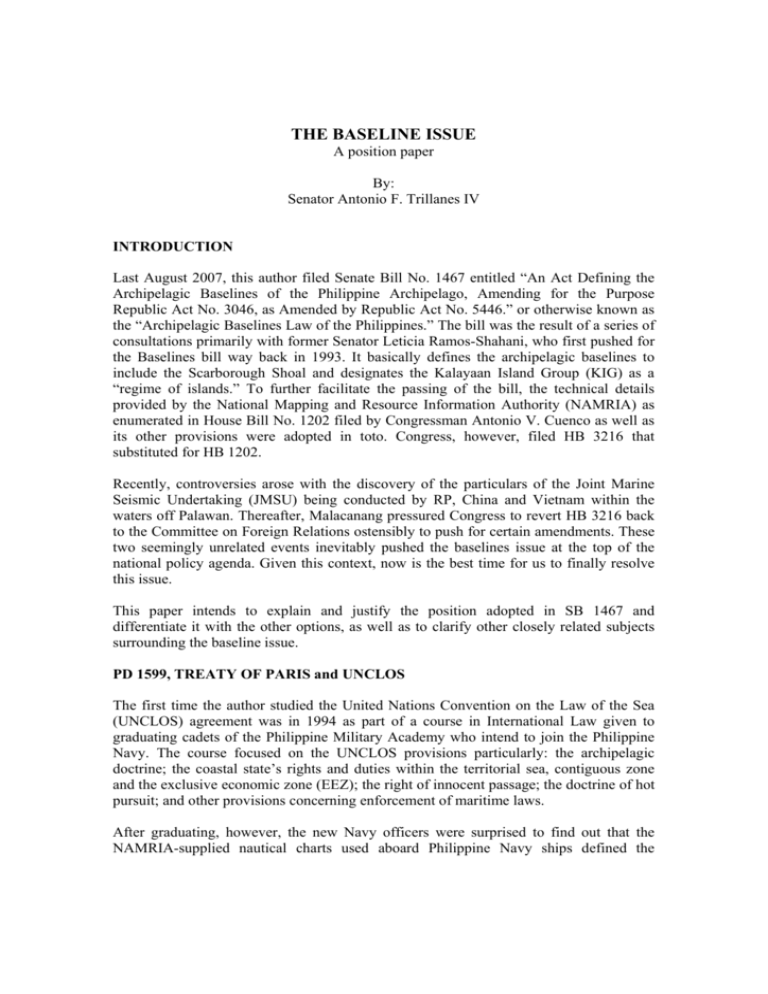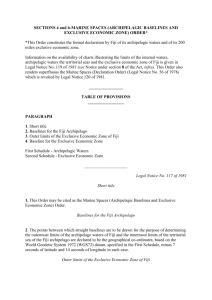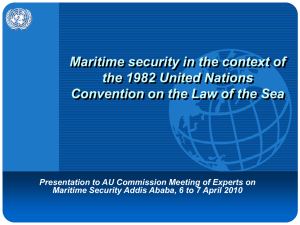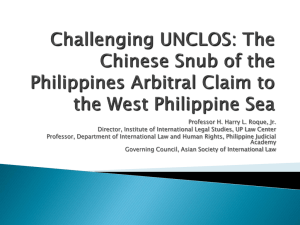the baseline issue
advertisement

THE BASELINE ISSUE A position paper By: Senator Antonio F. Trillanes IV INTRODUCTION Last August 2007, this author filed Senate Bill No. 1467 entitled “An Act Defining the Archipelagic Baselines of the Philippine Archipelago, Amending for the Purpose Republic Act No. 3046, as Amended by Republic Act No. 5446.” or otherwise known as the “Archipelagic Baselines Law of the Philippines.” The bill was the result of a series of consultations primarily with former Senator Leticia Ramos-Shahani, who first pushed for the Baselines bill way back in 1993. It basically defines the archipelagic baselines to include the Scarborough Shoal and designates the Kalayaan Island Group (KIG) as a “regime of islands.” To further facilitate the passing of the bill, the technical details provided by the National Mapping and Resource Information Authority (NAMRIA) as enumerated in House Bill No. 1202 filed by Congressman Antonio V. Cuenco as well as its other provisions were adopted in toto. Congress, however, filed HB 3216 that substituted for HB 1202. Recently, controversies arose with the discovery of the particulars of the Joint Marine Seismic Undertaking (JMSU) being conducted by RP, China and Vietnam within the waters off Palawan. Thereafter, Malacanang pressured Congress to revert HB 3216 back to the Committee on Foreign Relations ostensibly to push for certain amendments. These two seemingly unrelated events inevitably pushed the baselines issue at the top of the national policy agenda. Given this context, now is the best time for us to finally resolve this issue. This paper intends to explain and justify the position adopted in SB 1467 and differentiate it with the other options, as well as to clarify other closely related subjects surrounding the baseline issue. PD 1599, TREATY OF PARIS and UNCLOS The first time the author studied the United Nations Convention on the Law of the Sea (UNCLOS) agreement was in 1994 as part of a course in International Law given to graduating cadets of the Philippine Military Academy who intend to join the Philippine Navy. The course focused on the UNCLOS provisions particularly: the archipelagic doctrine; the coastal state’s rights and duties within the territorial sea, contiguous zone and the exclusive economic zone (EEZ); the right of innocent passage; the doctrine of hot pursuit; and other provisions concerning enforcement of maritime laws. After graduating, however, the new Navy officers were surprised to find out that the NAMRIA-supplied nautical charts used aboard Philippine Navy ships defined the territorial limits of the country as those stated in the Treaty of Paris plus the attached KIG borders defined by PD 1596, and not the UNCLOS definitions as taught to them at PMA. To be fair, NAMRIA has no other basis than the Treaty of Paris because our country, precisely, has yet to pass a new baselines law that would amend the pre-UNCLOS baseline law, the RA 5446, which is not compliant with the UNCLOS criteria. To complicate matters, the Navy uses PD 1599, a pre-UNCLOS unilateral declaration of our country’s EEZ, as a mandate to enforce maritime laws in these areas. As a consequence, the author remembers that when their ship patrolled as far east as the Anson Shoal in the Pacific, they used the Treaty of Paris as reference. And when they patrolled as far west as the Scarborough Shoal in the South China Sea, they used PD 1599. In short, as of the moment, we have two sets of boundaries (PD 1599 and Treaty of Paris with PD 1596) and we will yet define another one (UNCLOS). 1. PD 1599, as mentioned above, is a unilateral declaration by the Philippines of its EEZ as measured from the baselines as defined by RA 5446. It was signed by then Pres. Ferdinand Marcos on 11 June 1978. 2. The Treaty of Paris is a peace treaty forged between the US and Spain in 10 December 1898. It detailed, among others, the territorial limits of the Philippine archipelago as being ceded by Spain to the US. These same limits were then used to define our national territory when we eventually gained indepedence from the US in 1946. 3. The UNCLOS, formally known as the Third United Nations Convention on the Law of the Sea or UNCLOS III and also called the Law of the Sea Convention, refers to the international agreement that came out of the UN conferences from 1973 to 1982. The agreement consists of 320 articles and 9 annexes. To date, 155 countries have already ratified the UNCLOS and it officially came into force in 16 November 1994. The Philippines became the 11th country to ratify UNCLOS on 08 May 1984. It defines, among others, the limits of the territorial sea, contiguous zone and the EEZ of a coastal or archipelagic State. Each of the above reference options has its own strengths and weaknesses, but if we are to consider both the validity in International Law and the area covered, the UNCLOS option is superior to the other two. PD 1599, while almost as vast as the UNCLOS option in terms of area, has practically no binding effect in International Law by virtue of its being a unilateral declaration in the pre-UNCLOS era. Moreover, since we have ratified UNCLOS and, therefore, agreed to its provisions, we are obliged to rescind PD 1599. The Treaty of Paris, meanwhile, may still have a binding effect in International Law, notwithstanding the UNCLOS ratification. However, its total area covered is significantly smaller because it cannot avail of the EEZ provisions of the UNCLOS. As to the legal alternative of retaining the Treaty of Paris while availing of the UNCLOS option, we, as a self-respecting people living within a community of nations, should not have two sets of boundaries that we can use for our own convenience. It is simply not fair; it is simply not right. Therefore, it is in our country’s best interest to adopt solely the UNCLOS option. THE BASELINE METHODS Baselines are reference lines drawn by a coastal or archipelagic State using different methods as discussed below. They are used to measure the breadth of the territorial sea (12nm), contiguous zone (24 nm), EEZ (200nm) and continental shelf (up to 350nm). Also, the waters enclosed by the baselines are called archipelagic waters over which an archipelagic State exercises sovereignty. According to the UNCLOS, there are three methods that can be employed in determining a State’s baselines, namely: 1. Normal Baseline, according to Art. 5, “is the low-water line along the coast as marked on large-scale charts officially recognized by the coastal State.” 2. Straight Baseline, according to Art. 7, can be employed if ever “the coastlines are indented and cut into or there is a fringe of islands along the coast in its immediate vicinity.” 3. Archipelagic Baseline, according to Art. 47, is a method of “joining the outermost points of the outermost islands and drying reefs of an archipelago provided that within such baselines are included the main island and an area in which the ratio of the area of the water to the area of the land, including atolls, is between 1:1 and 9:1.” Of the three methods, the archipelagic baselines method is most applicable and advantageous to an archipelago such as ours. Otherwise, to use either the Normal or Straight baseline methods, which are primarily designed for coastal States, would effectively waive our status as an archipelagic State and lose much of the archipelagic waters as defined above. THE BASELINE OPTIONS NAMRIA has prepared the following baseline options to cater to the varying political persuasions of the policymakers: 1. OPTION 1: The main archipelago and Scarborough Shoal are enclosed by the baselines while KIG is classified as regime of islands. This is the option adopted by SB 1467. 2. OPTION 2: Only the main archipelago is enclosed by the baselines while KIG and Scarborough Shoal are classified as regime of islands. This is the official position of Malacanang through recent pronouncements and the DFA position paper written on 02 Aug 2005. 3. OPTION 3: The main archipelago and KIG are enclosed by the baselines while Scarborough Shoal is classified as regime of islands. 4. OPTION 4: The main archipelago, KIG and Scarborough Shoal are enclosed by the baselines. This is the option adopted by HB 3216. To have a better view of the differences between the baseline options, the table below (which includes RA 5446) was lifted from the briefing documents prepared by NAMRIA. THE BASELINE OPTIONS FEATURES Baseline enclosure No. of baselines No. of long baseline (100-125nm) No. of basepoints occupied by other claimants Area of archipelagic waters* Area from baselines to EEZ limit** Total area of archi waters and EEZ Area under regime of islands Add’l requirement OPTION 1 (SB 1467) Main Archipelago & Scarborough OPTION 2 (Malacanang) Main Archipelago only 135 4 101 3 134 4 OPTION 4 (HB 3216) Main Archipelago, Scarborough & KIG 135 4 0 0 7 7 0 172,109 sq nm 171,146 sq nm 212,181 sq nm 210,443 sq nm 166,858sqnm 498,870 sq nm 485,310 sq nm 468,250 sq nm 468,250 sq nm 413,080sqnm 670,979 sq nm 656,456 sq nm 680,428 sq nm 691,233 sq nm 579,938sqnm KIG KIG & Scarborough Designation of sealanes Scarborough None None Designation of sealanes & construction of lighthouse at Sabina Shoal Designation of sealanes & construction of lighthouse at Sabina Shoal Designation of sealanes OPTION 3 Main Archipelago & KIG RA 5446 Main Archipelago only 80 1>125nm * Enclosed by the baselines ** Approximate median line applied and KIG unilaterally drawn based on PD 1596 RA 5446: There are a few weaknesses in RA 5446. One, it violates para 2 of Art. 47 of UNCLOS where it states: “The length of such baselines shall not exceed 100 nautical miles except that up to 3 percent of the total number of baselines enclosing the archipelago may exceed that length, up to a maximum of 125 nautical miles.” As we can see from the table, RA 5446 has one baseline that exceeds the 125nm limit for long baselines. Another weakness of RA 5446 is: it does not optimize the area of the EEZ since it excluded both Scaborough Shoal and KIG from the baselines and both were not designated as regime of islands. OPTION 1/ SB 1467: The main strength of this option is that it maximized the area by including Scarborough Shoal without violating the archipelagic baselines provisions by classifying KIG as regime of islands. It is, therefore, UNCLOS compliant. However, there are some misconceptions regarding the label “regime of islands” that it supposedly weakens our claim or reduces our sovereignty over the areas labeled as such. On the contrary, “regime of islands” is defined in Art. 121 as: 1) island/s that is naturally formed, surrounded by water and is above water at high tide; and 2) it shall have its own 12nm territorial sea, 24nm contiguous zone, 200nm EEZ and continental shelf. In other words, islands classified as regime of islands are treated the exact same way as other land territory. The only possible reason that coastal States would be forced to classify their territory as a regime of islands is because such territory is impossible to enclose within the baselines without violating other UNCLOS provisions. The Falkland island group is one example. Since the UK is at the other end of the Atlantic which made it impossible to include Falkland in its own baseline, it has no choice but to classify Falkland as a regime of islands. The US (if ever it ratifies UNCLOS) would probably classify Hawaii as a regime of islands by virtue of its distance from the mainland. The Scarborough Shoal was included in the baselines primarily because its distance from Luzon is less than the 125nm limit. With this, our country stands to gain approximately 14,500sq nm of EEZ and continental shelf. Another reason for its inclusion is that Scarborough Shoal is basically a rock and according to para 3 of Art. 121, the regime of islands definition has an exception and that is: “Rocks which cannot sustain human habitation or economic life of their own shall have no exclusive economic zone or continental shelf.” Therefore, while it is advantageous for us to designate KIG as a regime of islands, we would be depriving ourselves of the EEZ and continental shelf of Scarborough Shoal if it would be designated as a regime of islands. Of course, China is expected to protest the inclusion of Scarborough Shoal within our baselines. Probably, it may even be the reason why Malacanang pressured Congress to freeze legislative action on HB 3216. But if we truly believe that our claim over Scarborough Shoal is legitimate then we have every right to enclose it within our baselines. This does not mean, though, that we are provoking China into a war because, according to Art. 279, State Parties to the UNCLOS are obliged to settle any dispute by peaceful means. OPTION 2/MALACANANG OPTION: The main weakness of this option is, while it is UNCLOS compliant, it failed to protect the interest of our country by not including Scarborough Shoal in the baselines when there is no hindrance to do so. True, this option designates Scarborough as a regime of islands but, as discussed above, a rock formation is not entitled to an EEZ and continental shelf when labeled as such. Even if it will still have its own territorial sea and contiguous zone, these would have no effect in terms of additional area since the EEZ measured from west coast of Luzon will extend over these zones. OPTION 3: There are several weaknesses with this option. Aside from those mentioned in Option 2 with the designation of Scarborough Shoal as regime of islands, this option is also not UNCLOS compliant for including KIG in the baselines. This will be discussed extensively below since Option 4 also included KIG in the baselines. OPTION 4/HB 3216: At first glance, this may seem to be the best option. However, it violated para 4 of Art. 47 which states: “Such baselines shall not be drawn to and from low-tide elevations, unless a lighthouse or similar installations which are permanently above sea level have been built on them or where a low-tide elevation is situated wholly or partly at a distance not exceeding the breadth of the territorial sea from the nearest island.” Based on the table above and HB 3216 itself, Sabina Shoal and Iroquois Reef are low-tide elevations. A low-tide elevation, according to Art. 13, “is a naturally formed area of land which is surrounded by and above water at low-tide but submerged at high tide.” Hence, we still need to construct a lighthouse each on these areas so that they can qualify as basepoints. Even this measure, however, is no longer possible because of the “Declaration on the Conduct of Parties in the South China Sea” which was signed by the ASEAN members and China in 2002. In the declaration, we agreed “to exercise selfrestraint in the conduct of activities that would complicate or escalate disputes and affect peace and stability including, among others, refraining from action of inhabiting on the presently uninhabited islands, reefs, shoals, cays, and other features and to handle their differences in a constructive manner.” Both Sabina Shoal and Iroquois Reef are presently uninhabited but are being claimed by RP, China and Vietnam. Another major defect of Option 4/HB3216 is, as we can see from the table, seven of the designated basepoints are islands presently occupied by other countries. According to the Digital Gazetteer of the Spratly Isands, these are: Kalantiaw Cay (Vietnam); Paredes Reef (Vietnam); Kagitingan Reef (China); Mariveles Reef (Malaysia); Pugad Is. (Vietnam); Kanluran Reef (Vietnam) and Investigator Reef (being claimed by China). To insist on using these islands/reefs as basepoints is in contravention of the 2002 ASEANChina Declaration on the Conduct of Parties in the South China Sea and may cause outrage among affected States. Designating basepoints on uninhabited, though contested areas such as Scarborough Shoal can be defended legally and politically. But to place basepoints on foreign-occupied territory, no matter how strong our claim, is an act of aggression. If the proponents of Option 4/HB 3216 have not yet realized this, then the information provided by this paper, hopefully, will make them reconsider. In view of the discussions above, the best option to adopt is Option 1 as stated in SB 1467. The SPRATLY ISSUE As explained above, the passing of SB 1467 will not weaken our claim over the Kalayaan Island Group (KIG) or what is internationally known as the Spratlys. Still, the fact remains that, we are only one of many claimants in that group of islands. Of these, only Brunei has not physically occupied its claimed territory. According to the Digital Gazetteer of the Spratly Islands (it admits the reports are varying), Vietnam has occupied 25 islands; China, 13; RP, 8; Malaysia, 5; and Taiwan, 1. With this situation, it is impossible to expect a scenario where all these countries will just suddenly pack up and go home. On the contrary, we should even expect some of these claimants to assert their presence more in the coming years to explore potential oil deposits amidst the increasing demand and diminishing oil reserves elsewhere. In such a scenario, skirmishes are not unlikely as our Navy ships and fishing boats are regularly navigating these waters. In the meantime, nobody gets to benefit from whatever rich natural resources the area has to offer. There are several avenues enumerated in the UNCLOS as regards conflict settlement, foremost of which is the mutual agreement of all claimant States. But after factoring in the unpleasant experiences (including our own) of countries conducting joint development agreements with China (Wain 2008), it may be best to strengthen ties within the ASEAN first. This way, our collective position would be at parity with China in any future agreement. This is the only peaceful way to resolve this issue. The JMSU ISSUE The Joint Marine Seismic Undertaking (JMSU) was initially entered into by RP and China on 01 Sept 2004. Vietnam initially voiced concern as it was a violation of the 2002 Declaration on the Conduct of Parties in the South China Sea (Wain 2008). But at some point, Vietnam was won over when it was included in the project. Because of this, it is now officially called a Tripartite Agreement for Joint Marine Seismic Undertaking in The Agreement Area in the South China Sea. The JMSU agreement is highly flawed for the following reasons: 1. It smacks of bad faith on our part as it was forged without consulting with the other members of the ASEAN while there was an existing status quo agreement among them. (Wain 2008). 2. It excluded other claimant States like Brunei, Malaysia and Taiwan. 3. It was grossly disadvantageous on our part because it included areas that were not disputed. 4. Because some subject areas are solely ours, it violated certain provisions of Art. XII of the 1987 Constitution relating to the exclusive use of our own marine wealth or, if it is a joint exploration, the President’s obligation to submit such agreement to Congress within 30 days. 5. We are not at parity with China in terms of the actual conduct of the exploration since we are relegated to mere observers aboard their research vessels. Hence, there can be no guarantees about the integrity of the research results. The CONTINENTAL SHELF According to para 1 of Art. 76 of the UNCLOS, “the continental shelf of a coastal State comprises the sea-bed and subsoil of the submarine areas that extend beyond its territorial sea throughout the natural prolongation of its land territory to the outer edge of the continental margin, or to a distance of 200nm from the baselines from which the territorial sea is measured where the outer edge of the continental margin does not extend up to that distance.” According to para 6 to 8 of Art. 76, a coastal State is allowed to claim the outer limits of a continental shelf beyond the 200nm but not exceeding 350nm from the baselines as long as the information on the said limits are submitted to the Commission on the Limits of the Continental Shelf (CLCS). The CLCS would then make the recommendations to the coastal State regarding the outer limits and the adoption of which would make it final and binding. Art. 4 of Annex II, on the other hand, states: “Where a coastal State intends to establish, in accordance with Art. 76, the outer limits of its continental shelf beyond 200nm, it shall submit particulars of such limits to the Commission along with supporting scientific and technical data as soon as possible but in any case within 10 years of the entry into force of this Convention for that State.” Since the UNCLOS officially entered into force 16 November 1994, supposedly, the tenyear deadline would have expired on 15 November 2004. However, because of the difficulties encountered by developing countries in coming up with technical requirements of Art. 4 of Annex II, a decision was made during the May 2001 Meeting of State Parties to UNCLOS to extend the deadline to 12 May 2009. (Sands 2005: 5). With this, our country has a little over a year to submit the particulars of our continental shelf beyond the 200nm to the CLCS. Thus, it is imperative that all pertinent institutions of government provide and extend all the necessary support to NAMRIA to make sure that it accomplishes its mission on time. To compound this deadline problem, we still do not have a new baselines law from which to measure the outer limits of our continental shelf. While there is no deadline in the submission of particulars for a State’s baselines, it is, however, the basis for measuring all maritime regimes including the extended continental shelf (VERA Files 2008). Therefore, we should pass the new baselines bill even way before the 12 May 2009 deadline to give NAMRIA ample time to adjust their data on our continental shelf, assuming that it would have the necessary data by then. The SABAH CLAIM The approval of SB 1467 is without prejudice to our existing claim on Sabah. Although the bill is not as explicit as Sec. 2 of RA 5446 where it mentioned that RP has dominion and sovereignty over Sabah, still Sec. 5 of SB 1467 states that the baselines law shall be without prejudice to other claims. To be sure, Article I of the 1987 Constitution has already covered our claim over Sabah and other similarly situated territories and no law can possibly override this Constitutional provision. Having said that, the Sabah claim will always be a lingering issue for as long as we will not be brave enough to confront it. Sadly, all the administrations since 1986 refused or lacked the political will to resolve it. As things stand, our country has a strong existing legitimate claim over Sabah, on behalf of the heirs of the Sultanate of Sulu. On the other hand, Malaysia had been in actual possession and control over the island for more than a century now and, worse, the inhabitants of Sabah have expressed their desire to remain under Malaysian rule. Hence, it is very unlikely that Malaysia would give up its claim even with extreme pressure from the international community. Maintaining status quo may be the preferred option of our past and present National leaders so as to avoid either being accused of selling-out our interests, or creating tension in diplomatic ties with Malaysia. However, maintaining status quo is favorable to Malaysia as they continue to possess, control and exploit Sabah. Moreover, as time passes by that the issue is not resolved, the farther removed are we from the actual circumstances on how Malaysia got to possess Sabah in the first place, which is essential to proving our claim. And, of course, the heirs of the Sultanate of Sulu are continuously deprived of their inheritance. War is definitely not an option not only because our armed forces are ill-equipped for such an endeavor but, more importantly, because we, as a people, have not reached and is nowhere near the level of nationalism and patriotism necessary for launching a politically, socially and economically costly undertaking such as a full-scale war with another country. Pragmatically, therefore, the only option to resolve the Sabah issue is a compromise settlement between RP, Malaysia and the heirs of the Sultanate of Sulu. The author concedes, however, that even this option would not be easily accomplished but then again, reasonable men will always reach a point of agreement. RECOMMENDATIONS 1. Push for the passing of SB 1467 and its counterpart in Congress before May 2009 so that there will be a basis for measuring the outer limits of the territorial sea, contiguous zone, exclusive economic zone and continental shelf. More importantly, so that our country can now officially claim the limits of our National Territory that is consistent with the international covenant of UNCLOS. 2. Push for the submission of particulars of the outer limits of the continental shelf to the UN Commission on the Limits of the Continental Shelf before the 12 May 2009 deadline by supporting NAMRIA and other concerned agencies in their data gathering. 3. On the assumption that recommendations 1 and 2 as stated above are achieved, we should do the following: A. Modernize our fishing methods and technologies; B. Invest heavily on marine scientific research and exploration of the EEZ and continental shelf; C. Reach out to other claimant States of the contested territories in order to settle disputes and come up with an agreement for joint exploration and development so that all these States can finally benefit from the abundant natural resources in these areas. D. Comply with the other UNCLOS obligations of an archipelagic State. 4. Modernize the Navy and Coast Guard. Logically, the next step after having firmly and clearly established our territory is to protect it. Aside from the basic demands of naval defense, we should increase our capability for maritime law enforcement operations. 5. Conduct a legislative inquiry on the Tripartite Agreement for Joint Marine Seismic Undertaking. CONCLUSION As shown in the discussions above, the baseline issue is quite technical and highly complex because of the interplay with other equally important national security, economy and foreign policy issues. But after carefully analyzing these issues separately, this paper tried its best to come up with reasonable and feasible courses of action which, hopefully, would be given due consideration. Still, everything starts when we finally make a stand, as a Nation, by defining the limits of what is truly ours and what will be good for our country now and in the generations to come. REFERENCES 2008 VERA Files (Tordesillas, Ellen et.al.). “Arroyo neglect, government infighting jeopardize RP’s territorial claim.” 24 March 2008. Downloaded from www.ellentordesillas.com. 2008 Wain, Barry. “Manila’s Bungle in The South China Sea.” Far Eastern Economic Review. January/February 2008. 2008 Digital Gazetteer of the Spratly http://community.middlebury.edu. 2008 NAMRIA Nautical Chart No. 4723 (provisional copy). Philippines. 2007 Trillanes, Antonio IV F. Senate Bill No. 1467: An Act Defining the Archipelagic Baselines of the Philippine Archipelago, Amending for the Purpose Republic Act No. 3046 as Amended by Republic Act No. 5446. Senate of the Philippines. 2007 Cuenco, Antonio V. House Bill No. 1202: An Act Defining the Archipelagic Baselines of the Philippine Archipelago, Amending for the Purpose Republic Act No. 3046 as Amended by Republic Act No. 5446. Congress of the Philippines. 2007 Cuenco, Antonio V. et.al. House Bill No. 3216: An Act Defining the Archipelagic Baselines of the Philippine Archipelago, Amending for the Purpose Republic Act No. 3046 as Amended by Republic Act No. 5446. Congress of the Philippines. 2005 Sands, Philippe. “Introductory Note on Issues Concerning Rights/Obligations and Deadlines Under Part XI of UNCLOS in Relation to the Extended Continental Shelf.” Written for the Meeting of Commonwealth Law Ministers and Senior Officials. Ghana. 17-20 October 2005. 2005 Department of Foreign Affairs. Position Paper: “Determination of Baselines.” 02 Aug 2005. 2005 “Joint Statement on the Signing of a Tripartite Agreement for Joint Marine Seismic Undertaking in the The Agreement Area in the South China Sea.” Makati, Philippines. 14 March 2005. Downloaded from http://chinajapan21.org. 2004 NAMRIA Nautical Chart No. 4200. Philippines. Islands. Downloaded from 2004 Agreement for Joint Marine Seismic Undertaking in Certain Areas in the South China Sea By and between China National Offshore Oil Company And Philippine National Oil Company. Beijing, China. 01 September 2004. 2002 “Declaration on the Conduct of Parties in the South China Sea.” Phnom Penh, Cambodia. 04 November 2002. 1999 Zou, Keyuan. “Scarborough Reef: A New Flashpoint in Sino-Philippine Relations?” International Boundaries Research Unit. Canada. 1987 Constitution of the Republic of the Philippines. 1982 United Nations Convention on the Law of the Sea. 10 December 1982. 1978 Presidential Decree No. 1596: Declaring Certain Area Part of the Philippine Territory and Providing for their Government and Administration. Philippines. 11 June 1978. 1978 Presidential Decree No. 1599: Establishing an Exclusive Economic Zone and for Other Purposes. Philippines. 11 June 1978. 1968 Republic Act. No. 5446: An Act to Amend Section One of Republic Act. No. 3046, Entitled “An Act to Define the Baselines of the Territorial Sea of the Philippines.” Philippines. 18 September 1968. 1961 Republic Act No. 3046: An Act to Define the Baselines of the Territorial Sea of the Philippines. Philippines. 17 June 1961. 1898 The Treaty of Paris. France. 10 December 1898. * Other presentation documents, tables, charts and illustrations provided by NAMRIA.







